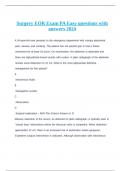Surgery EOR Exam PA Easy questions with
answers 2024
A t54-year-old tman tpresents tto tthe temergency tdepartment twith tcrampy tabdominal
tpain, tnausea, tand tvomiting. tThe tpatient thas tnot tpassed tgas tor thad ta tbowel
tmovement tfor tat tleast t10 thours. tOn texamination, tthe tabdomen tis tdistended tand
tthere tare thigh-pitched tbowel tsounds twith trushes. tA tplain tradiograph tof tthe tabdomen
treveals tcecal tdistension tto t12 tcm. tWhat tis tthe tmost tappropriate tdefinitive
tmanagement tfor tthis tpatient?
A
tIntravenous tfluids t
B
tNasogastric tsuction t
C
tObservation t
D
tSurgical texploration t- tANS-The tCorrect tAnswer tis: tD t
Massive tdistention tof tthe tcecum, tas tdetected ton tplain tradiograph, tis ttypically tseen tin
t"closed tloop" tobstructions twhere tthe tileocecal tvalve tis tcompetent. tWhen tdistention
tapproaches t12 tcm, tthere tis tan tincreased trisk tof tperforation tand/or tgangrene.
tExpedient tsurgical tintervention tis tindicated. tAlthough tobservation twith tintravenous
,tfluids tand tnasogastric tdecompression tare timportant tadjuncts tto tmanagement,
tsurgical texploration tis tthe tonly tway tto trapidly taddress tthis temergent tsituation.
When ta tbone tis tfractured, tthere tare tthe t3 tstages tof thealing. tWhat tis tthe tproper torder
tin twhich tthe thealing toccurs?
A
tInflammatory, tRemodeling, tReparative t
B
tInflammatory, tReparative, tRemodeling t
C
tRemodeling, tInflammatory, tReparative t
D
tRemodeling, tReparative, tInflammatory t
E
tReparative, tInflammatory, tRemodeling t- tANS-The tCorrect tAnswer tis: tB t
Inflammatory tchanges thappen tafter tfractures tand tthis tis tfollowed tby ta treparative
tphase tand tultimately, ta tremodeling tphase. tThe thealing tfrom tacute tinjuries tgenerally
tstarts twith tinflammation,. tOnce tthe tintegrity tof tthe tbone thas tbeen trestored ton tthe
tmacro tlevel, tbone tremodeling tcontinues tuntil tfull thealing thas toccurred.
What tis tthe tmost tcommon tembolic tsource tof tacute tarterial tocclusion tin tthe tlower
textremities?
A
,tAtrial tfibrillation t
B
tAortic taneurysm t
C
tMyocardial tinfarction t
D
tProsthetic tcardiac tvalve t
E
tIliac tartery tthrombus t- tANS-The tCorrect tAnswer tis: tA t
The theart taccounts tfor t80% tof tall temboli, twith tatrial tfibrillation tmaking tup t70% tof
tthat. tAortic taneurysms tare tfrequently tlined twith tthrombus tbut tinfrequently tembolize;
taneurysmal tdisease tonly taccounts tfor t6% tof tall tacute tarterial tocclusion. tAcute
tmyocardial tinfarction t(especially tthose tassociated twith tleft tventricular tthrombus)
taccounts tfor t25% tof tcardioembolism, twith tperipheral tembolization toften tthe tfirst tsign
tof ta tpreviously t"silent" tMI. tProsthetic tcardiac tvalves tmake tup ta tstill tsmall tbut
tincreasingly tprevalent tsource tof temboli. tPeripheral tarterial tthrombi taccount tfor tonly
t3% tof tacute tocclusion.
Following temergent tappendectomy, ta t58-year-old tobese tmale tdevelops ta
ttemperature tof t102.4˚F, t18 thours tpostoperatively. tHis trespiratory trate tis t26 tand this
tpulse tis t116bpm. tA tphysical texam treveals tscattered tfine trales. tWhat tis tthe tmost
tlikely tdiagnosis?
A
, tAtelectasis t
B
tAspiration tpneumonitis t
C
tPleural teffusion t
D
tPneumonia t
E
tPulmonary tembolus t- tANS-The tCorrect tAnswer tis: tA t
Pulmonary talveoli tcollapse, talso tknown tas tatelectasis, toccurs tduring toperative
tprocedures tfor ta tvariety tof treasons, tincluding tdecreased tclearance tof tsecretions tand
tdecreased tintra-alveolar tpressure. tPostoperatively, toften tdue tto tpain, tpatients tmay
tnot tmobilize tsecretions tappropriately, talso tcontributing tto tatelectasis. tAtelectasis tis
tthe tmost tcommon tpostoperative tpulmonary tcomplication, tand tis toften tassociated twith
temergent tand tprolonged tsurgeries, tespecially tthose tof tthe tthorax tand tabdomen.
tAtelectasis tis tassociated twith tfever, tan tincreased trespiratory trate, tan tincreased
tpulse, tand tlung texam tfindings tranging tfrom tnormal tto trales tand tdecreased tbreath
tsounds. tSymptoms tusually tpresent twithin tthe tfirst t48 thours tpostoperatively.
tPulmonary taspiration tpneumonitis, talthough tpossible, tis tless tlikely tdue tto tappropriate
tpreoperative tand tintraoperative tmeasures tbeing tutilized tto tdecrease trisk. tPneumonia
tis talso ta tcommon tpostoperative tcomplication, tdue tto tthe tsame tcontributing tfactors tas
tatelectasis. tPhysical texam tfindings tmay talso tbe tsimilar. tHowever, tpostoperative
tpneumonia tis tlikely tto tbecome tevident tbetween t24 tand t96 thours tpostoperatively.




